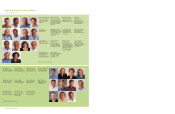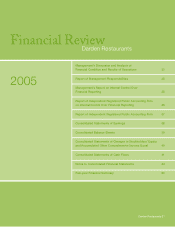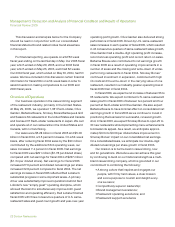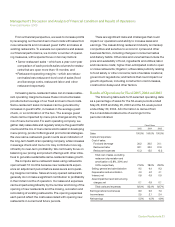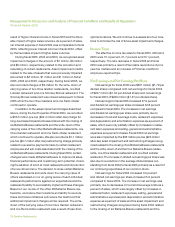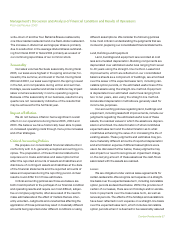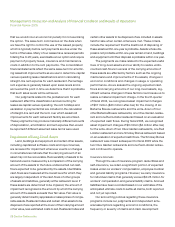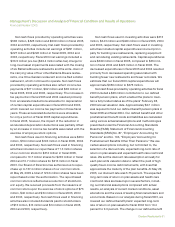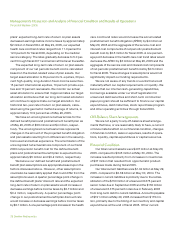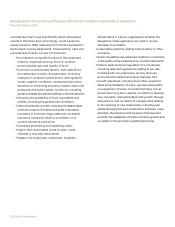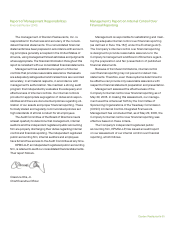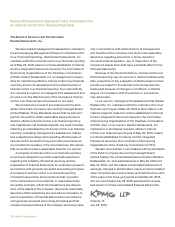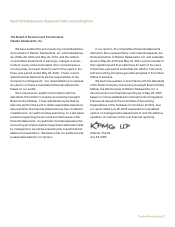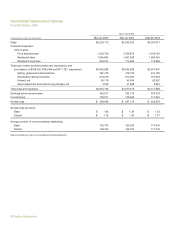Red Lobster 2005 Annual Report Download - page 21
Download and view the complete annual report
Please find page 21 of the 2005 Red Lobster annual report below. You can navigate through the pages in the report by either clicking on the pages listed below, or by using the keyword search tool below to find specific information within the annual report.Management’s Discussion and Analysis of Financial Condition and Results of Operations
Financial Review 2005
Darden Restaurants 29
patterns and claim reserve, management and settlement
practices. Unanticipated changes in these factors may
produce materially different amounts of reported expense
under these programs.
Income Taxes
We estimate certain components of our provision for
income taxes. These estimates include, among other
items, depreciation and amortization expense allowable for
tax purposes, allowable tax credits for items such as taxes
paid on reported employee tip income, effective rates for
state and local income taxes and the tax deductibility of
certain other items.
Our estimates are based on the best available informa-
tion at the time that we prepare the provision. We generally
file our annual income tax returns several months after our
fiscal year-end. Income tax returns are subject to audit by
federal, state and local governments, generally years after
the returns are filed. These returns could be subject to mate-
rial adjustments or differing interpretations of the tax laws.
Liquidity and Capital Resources
Cash flows generated from operating activities provide
us with a significant source of liquidity, which we use to
finance the purchases of land, buildings and equipment and
to repurchase shares of our common stock. Since substan-
tially all our sales are for cash and cash equivalents and
accounts payable are generally due in five to 30 days, we
are able to carry current liabilities in excess of current
assets. In addition to cash flows from operations, we use
a combination of long-term and short-term borrowings to
fund our capital needs.
We manage our business and our financial ratios to
maintain an investment grade bond rating, which allows
flexible access to financing at reasonable costs. Currently,
our publicly issued long-term debt carries “Baa1” (Moody’s
Investors Service), “BBB+” (Standard & Poor’s) and
“BBB+” (Fitch) ratings. Our commercial paper has ratings
of “P-2” (Moody’s Investors Service), “A-2” (Standard &
Poor’s) and “F-2” (Fitch). These ratings are as of the date
of this annual report and have been obtained with the
understanding that Moody’s Investors Service, Standard
& Poor’s and Fitch will continue to monitor our credit and
make future adjustments to these ratings to the extent
warranted. The ratings may be changed, superseded, or
withdrawn at any time.
Our commercial paper program is our primary source
of short-term financing. At May 29, 2005, there were no
borrowings outstanding under the program. To support our
commercial paper program, we have a credit facility under a
Credit Agreement dated October 17, 2003, as amended, with
a consortium of banks, including Wachovia Bank, N.A., as
administrative agent, under which we can borrow up to $400
million. The credit facility allows us to borrow at interest rates
based on a spread over (i) LIBOR or (ii) a base rate that is the
higher of the prime rate, or one-half of one percent above the
federal funds rate, at our option. The interest rate spread over
LIBOR is determined by our debt rating. The credit facility
expires on October 17, 2008 and contains various restric-
tive covenants, including a leverage test that requires us to
maintain a ratio of consolidated total debt to consolidated
total capitalization of less than 0.55 to 1.00 and a limitation
of $25 million on priority debt, subject to certain exceptions.
The credit facility does not, however, contain a prohibition on
borrowing in the event of a ratings downgrade or a “material
adverse change,” as defined in the Credit Agreement. None
of these covenants are expected to impact our liquidity or
capital resources. At May 29, 2005, we were in compliance
with all covenants under the Credit Agreement.
At May 29, 2005, our long-term debt consisted princi-
pally of: (1) $150 million of unsecured 5.75 percent medium-
term notes due in March 2007, (2) $75 million of unsecured
7.45 percent medium-term notes due in April 2011, (3)
$100 million of unsecured 7.125 percent debentures due in
February 2016 and (4) an unsecured, variable rate $27 million
commercial bank loan due in December 2018 that is used to
support two loans from us to the Employee Stock Ownership
Plan portion of the Darden Savings Plan. We also have
$150 million of unsecured 8.375 percent senior notes due in
September 2005 and $150 million of unsecured 6.375 per-
cent notes due in February 2006 included in current liabilities,
which we plan to repay through the issuance of unsecured
debt securities in fiscal 2006. Through a shelf registration on
file with the Securities and Exchange Commission (SEC), we
may issue up to an additional $125 million of unsecured debt
securities from time to time. The debt securities may bear
interest at either fixed or floating rates and may have maturity
dates of nine months or more after issuance.



